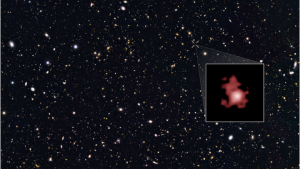It’s astounding that the most recent triumph of the Hubble telescope gives us a snapshot of the universe from 97% of the way back to the big bang. The light from a galaxy GN-z11 has travelled 13.4 billion years before being captured by the telescope and interpreted by scientists at Yale University. This is the furthest object we have ever observed, shattering the pre-existing record at seeing 13.2billion years into the past.

- The galaxy GN-z11 is picked out here. Image by NASA, ESA, P. Oesch, and I. Momcheva, and the 3D-HST and HUDF09/XDF teams.
The finding is important because these glimpses of the universe from so very long ago allow scientists to test their theories about how the universe developed and grew after the Big Bang. The theory is that at this point in time giant hot stars nucleated from clouds of cold neutral gas and the death of these stars produced the first heavy elements. GN-z11 is already “challenging some of our models” of this process according to Dr Pascal Oesch an astronomer involved in the research. In particular what has struck the scientists is that the galaxy is far brighter and is producing stars much faster than the theory expects.
The Yale astronomer claims this is “the pinnacle of Hubble’s exploration of galaxies” and indeed it seems that the stage is set for the next era in astronomy. In 2018 the James Webb telescope is scheduled to launch which is hoped to allow astronomers to see back as far as just 100 million years after the big bang with the hope of seeing the first stars to ever exist.
Photo credit: http://www.bbc.co.uk/news/science-environment-35721734
![Hubble glimpses the furthest galaxy yet It’s astounding that the most recent triumph of the Hubble telescope gives us a snapshot of the universe from 97% of the way back to […]](/wp-content/uploads/2016/03/hubble-620x300.jpg)